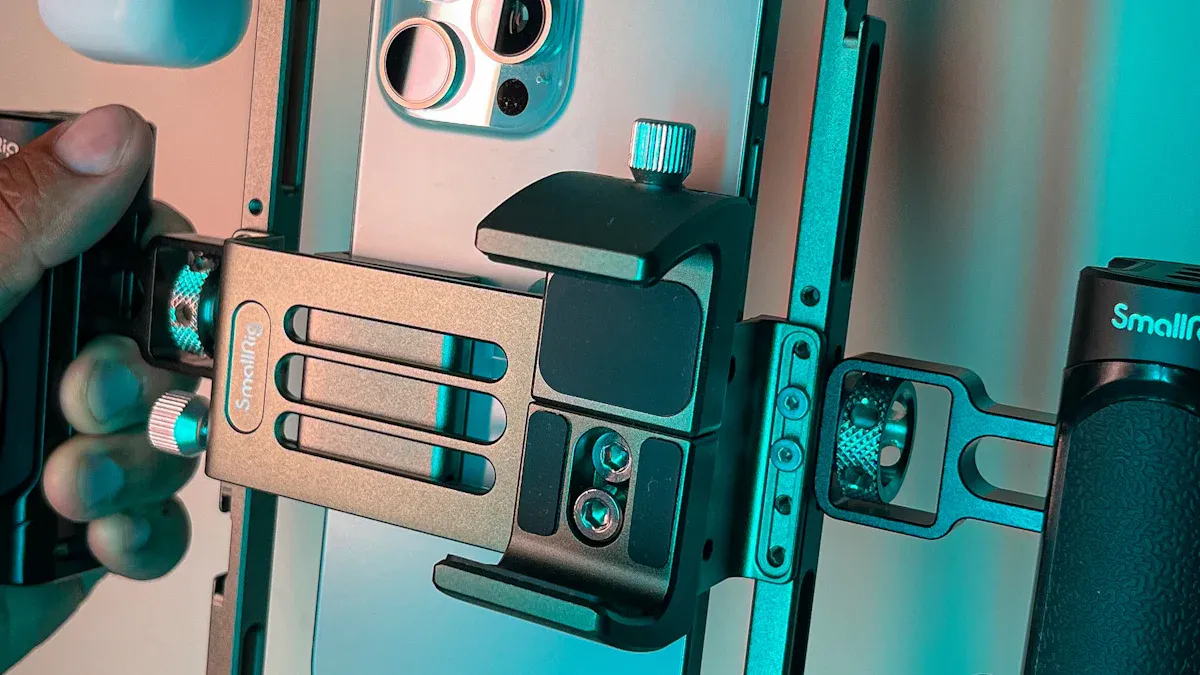What are EO/IR Pods and How Do They Work

EO/IR pods, or Electro-Optical/Infra-Red systems, serve as advanced imaging tools utilized in military and law enforcement. These systems combine visible and infrared sensors, enabling effective surveillance both day and night. Key features include long-range imaging, image stabilization, and the capability to identify and track targets under challenging conditions.
The significance of EO/IR pods in modern defense cannot be overstated. In 2023, they accounted for 45.30% of the revenue share in EO systems, highlighting their critical role in enhancing situational awareness and operational effectiveness.
Key Takeaways
EO/IR pods use visible and infrared sensors for watching day and night.
These systems help with awareness and effectiveness in the military and police.
EO/IR technology helps find targets far away and stream video live.
New improvements include AI, which helps make better decisions faster.
EO/IR pods are flexible and can be used on planes, cars, and ships for many uses.
Understanding EO/IR Technology

Components of EO/IR Pods
EO/IR pods consist of several critical components that work together to provide advanced imaging capabilities. These components include:
Electro-Optical Sensors: These sensors capture visible light, allowing operators to see targets clearly during the day.
Infrared Sensors: IR sensors detect heat emitted by objects, enabling visibility in low-light or obscured conditions.
Stabilization Systems: These systems reduce motion blur, ensuring clear images even when the platform is in motion.
Data Processing Units: These units analyze and process the data collected by the sensors, enhancing image quality and providing actionable intelligence.
Imaging Capabilities
The imaging capabilities of EO/IR technology are impressive. The combination of electro-optical and infrared sensors allows for versatile imaging under various conditions. Operators can achieve:
Day and Night Operations: EO/IR pods function effectively in both daylight and nighttime scenarios, providing continuous surveillance.
Long-Range Target Identification: The advanced sensors enable operators to identify and track targets from significant distances, enhancing situational awareness.
Real-Time Video Streaming: Many EO/IR systems offer live video feeds, allowing for immediate decision-making during critical operations.
Mounting Options
EO/IR pods come with various mounting options to suit different platforms. Common mounting configurations include:
Airborne Platforms: These pods can be mounted on aircraft, drones, or helicopters, providing aerial surveillance capabilities.
Ground Vehicles: Military vehicles often utilize EO/IR pods for reconnaissance and target acquisition on the battlefield.
Naval Vessels: Ships and submarines can integrate these systems for maritime surveillance and threat detection.
The flexibility in mounting options ensures that EO/IR technology can adapt to diverse operational needs.
Applications of EO/IR Pods

EO/IR pods find extensive applications across various domains, significantly enhancing operational capabilities.
Airborne Applications
In airborne operations, EO/IR pods play a crucial role in improving situational awareness. They enable military forces to conduct target detection and tracking, which enhances operational effectiveness. These systems also support area monitoring, providing comprehensive surveillance capabilities. Notably, EO/IR technology aids in mine and IED detection, increasing safety for ground troops. Furthermore, they assist in environmental monitoring, which supports mission planning under various conditions. The table below summarizes key airborne applications and their benefits:
Application Area | Benefits |
|---|---|
Military ISR operations | Provides real-time intelligence and reconnaissance capabilities. |
Surveillance missions | Enhances situational awareness and target identification. |
Environmental monitoring | Allows for assessment of conditions in challenging visibility. |
Border security | Improves monitoring and detection of unauthorized crossings. |
Target detection and tracking | Facilitates precise engagement and operational planning. |
Ground-Based Applications
EO/IR pods are equally effective in ground-based applications. These systems utilize various sensors, including visible light and infrared, to provide comprehensive situational awareness both day and night. Their passive operation renders them undetectable to adversaries, making them invaluable for military and law enforcement applications. They excel in short- to medium-range surveillance, enhancing tactical operations and situational awareness in combat zones.
Naval Applications
In naval operations, EO/IR technology significantly enhances maritime capabilities. Advanced software analyzes various signals, enabling better target discrimination and identification in complex environments. This capability is essential for operational effectiveness. Recent advancements provide naval forces with a 360-degree view of their surroundings, increasing situational awareness. EO/IR sensors offer long-range, day-night surveillance capabilities, allowing naval forces to identify targets and assess threats effectively. This technology is crucial for navigation, force protection, and engagement support in maritime operations.
Innovations in EO/IR Systems
FLIR Technology
Forward Looking Infrared (FLIR) technology represents a significant advancement in EO/IR systems. This technology allows operators to detect and visualize thermal radiation emitted by objects, making it invaluable for surveillance and reconnaissance. Recent innovations in FLIR technology include:
Low-Cost, Size, Weight, and Power (C-SWaP): New developments focus on creating compact and lightweight EO/IR sensors. These sensors support distributed Intelligence, Surveillance, and Reconnaissance (ISR) in contested environments.
Enhanced Imaging Capabilities: The integration of broadband EO/IR, multispectral, and hyperspectral technologies improves target detection and identification.
Advanced Materials: The use of carbon-based and nanomaterials enhances the performance of EO properties, leading to better imaging results.
These innovations ensure that FLIR technology remains at the forefront of military and law enforcement applications, providing critical situational awareness.
Advancements in Sensor Technology
Recent advancements in sensor technology have transformed EO/IR systems, enhancing their effectiveness in various operational scenarios. Key developments include:
High-Definition Sensors: The transition from standard definition to high-definition (HD) sensors allows for clearer imagery, aiding in detailed observations from greater distances.
Sensor Fusion: The merger of EO and IR sensors leads to improved applications across military platforms. This trend enhances the capability to process and utilize data effectively.
Computational Imaging Techniques: Emerging techniques promise to revolutionize sensor design and functionality, allowing for real-time processing and analysis.
Experts indicate that these advancements are crucial for military forces facing complex operational challenges. The focus on better sensor fusion and aided target recognition (AITR) will enhance operational capabilities in future military applications.
Future Trends in EO/IR Technology
Integration with AI
The integration of artificial intelligence (AI) with EO/IR systems is set to revolutionize military operations. AI enhances decision-making capabilities, allowing operators to respond more effectively in dynamic environments. Key benefits of AI integration include:
Improved Situational Awareness: AI algorithms analyze vast amounts of data from EO/IR sensors, providing real-time insights.
Faster Data-Driven Responses: AI enables quicker identification of threats, allowing for timely action.
Autonomous Platforms: Future developments will see autonomous drones and vehicles utilizing advanced EO/IR systems for surveillance and targeting.
These advancements will significantly enhance operational capabilities, making military forces more agile and responsive.
Enhanced Data Processing
Recent advancements in EO/IR systems focus on improving data processing efficiency. Enhanced sensor technologies and new materials contribute to this progress. Notable trends include:
Sensor Fusion: Combining data from multiple EO and IR sensors improves situational awareness and target recognition.
Computational Imaging Techniques: These techniques enhance sensor functionality by integrating optics and processing, leading to better image quality.
Higher Resolution Sensors: Future systems will emphasize larger focal plane arrays (FPAs) for improved performance.
These enhancements address operational challenges and ensure that military forces can effectively process and utilize data in real-time. As a result, the integration of advanced technologies will lead to superior threat detection and situational awareness.
EO/IR pods play a vital role in modern defense and surveillance strategies. They provide a 360-degree view and operate effectively in all visibility conditions. These systems enable passive detection of various threats, including missiles and UAVs. Their modular design allows for independent upgrades, enhancing their adaptability.
As technology evolves, further advancements in EO/IR systems, such as low-cost sensor technology and sensor fusion, promise to revolutionize military operations. The integration of these technologies will enhance situational awareness and improve target acquisition accuracy, which are critical for military missions.
In summary, EO/IR systems significantly impact modern warfare, solidifying their importance in complex combat environments.
FAQ
What are the primary benefits of EO/IR pods?
EO/IR pods enhance situational awareness by providing real-time imaging capabilities. They operate effectively in various conditions, enabling military and law enforcement to detect and track targets both day and night.
How does EO/IR sensor fusion improve operations?
EO/IR sensor fusion combines data from multiple sensors, enhancing target recognition and situational awareness. This integration allows operators to make informed decisions quickly, improving overall operational effectiveness.
Can EO/IR pods be used in civilian applications?
Yes, EO/IR pods have civilian applications, including search and rescue missions, environmental monitoring, and border security. Their ability to operate in low visibility conditions makes them valuable for various non-military purposes.
What platforms can mount EO/IR pods?
EO/IR pods can be mounted on various platforms, including aircraft, drones, ground vehicles, and naval vessels. This versatility allows for tailored surveillance solutions across different operational environments.
How do advancements in EO/IR technology impact military strategy?
Advancements in EO/IR technology enhance military strategy by improving reconnaissance capabilities and target acquisition accuracy. Innovations like AI integration and sensor fusion enable faster decision-making and more effective mission planning.